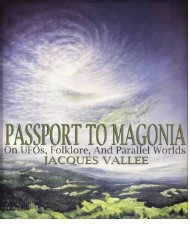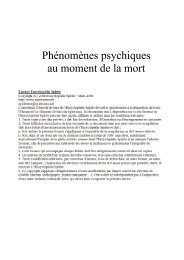extraordinary%20encounters
extraordinary%20encounters
extraordinary%20encounters
You also want an ePaper? Increase the reach of your titles
YUMPU automatically turns print PDFs into web optimized ePapers that Google loves.
156 Lemuria<br />
bridge. Others theorized that Lemuria was<br />
just part of a vast continent, called Gondwanaland,<br />
which had circled most of the<br />
Southern Hemisphere, leaving only a patch of<br />
the Pacific Ocean uncovered. None of the scientists<br />
argued that either Lemuria or Gondwanaland<br />
had survived into historical time.<br />
Lemuria entered the occult tradition<br />
through Helene Petrovna Blavatsky, founder<br />
of Theosophy. In The Secret Doctrine (1889),<br />
Blavatsky wrote that the present human race<br />
evolved through a series of “root races.” The<br />
third root race lived on Lemuria. These beings<br />
had three eyes, one in the back of the head,<br />
and were egg-laying hermaphrodites (possessing<br />
attributes of both sexes); some had four<br />
arms. Aside from these features, they were<br />
generally apelike in appearance.<br />
Other occult writers went on to create their<br />
own Lemurians. Through “astral clairvoyance”<br />
the English theosophist W. Scott-Elliot<br />
learned that it was on Lemuria that human<br />
beings entered physical bodies. The original<br />
Lemurians were twelve to fifteen feet tall, had<br />
flat faces and muzzles, and no foreheads.<br />
Their eyes were set so far apart that their vision<br />
extended sideways, and they had a third<br />
eye behind their heads. Eventually, these beings<br />
began to practice sex, and the Lhas, spirit<br />
entities who were to inhabit the bodies and<br />
guide them through evolution, were so repulsed<br />
that they refused their duty. The Lords<br />
of the Flame, advanced Venusians, took over<br />
and guided the Lemurians into a more human<br />
and spiritual state. During the Mesozoic era<br />
Lemuria began to break up, and one of its<br />
peninsulas became Atlantis.<br />
In the late nineteenth century, archaeologist<br />
Augustus Le Plongeon, working in the<br />
Yucatan, believed he had discovered how to<br />
translate Mayan hieroglyphics. His translations,<br />
which other scholars judged dubious,<br />
led him to believe that he had uncovered evidence<br />
of a lost civilization known as Mu. He<br />
assumed Mu to be Atlantis. After his death,<br />
however, his friend James Churchward, who<br />
had inherited Le Plungeon’s papers, argued<br />
that Mu, “the motherland of man,” had been<br />
in the South Pacific, not in the Atlantic. Mu<br />
housed a white population of some sixty-four<br />
million souls who had built great cities and<br />
worshipped the sun. Mu sank beneath the sea<br />
ten thousand years ago. Churchward claimed<br />
to have learned about Mu from tablets written<br />
in the dead Naacal language. He had been<br />
given access to them, he said, while serving in<br />
India in the Bengal Lancers. Churchward<br />
wrote about his “findings” in four books, beginning<br />
with The Lost Continent of Mu<br />
(1926). His failure to produce any evidence<br />
that the Naacal tablets existed outside his<br />
imagination sparked hoax charges that<br />
Churchward never successfully refuted.<br />
Soon Mu and Lemuria were assumed to be<br />
the same place, and thus Lemuria became a<br />
Pacific equivalent to the Atlantic’s Atlantis. In<br />
the early years of the twentieth century, speculation<br />
grew that California was a surviving<br />
fragment of Lemuria. A popular occult legend,<br />
apparently originating in a 1908 article<br />
in The Overland Monthly, held—and still<br />
holds—that a surviving Lemurian colony lives<br />
inside Mount Shasta, on the California-Oregon<br />
border. According to Lemuria: The Lost<br />
Continent of the Pacific (1931), by H. Spencer<br />
Lewis (writing as Wishar S. Cerve), when<br />
Lemuria broke up, a California-sized part of it<br />
crashed into North America’s west coast and<br />
attached itself. In 1936, Robert Stelle of<br />
Chicago founded the Lemurian Fellowship,<br />
based on his channeled messages from<br />
Lemurians living inside Mount Shasta. In two<br />
books published between 1940 and 1952,<br />
Stelle depicted Lemuria as an enormous land<br />
mass and a lost paradise.<br />
In the mid-1940s, the Ziff-Davis sciencefiction<br />
magazines Amazing Stories and Fantas -<br />
tic Adventures ran a series of stories and allegedly<br />
factual articles based in part on<br />
Richard S. Shaver’s “memories” of life in<br />
Lemuria, some of whose inhabitants still reside<br />
under the earth. Most have gone mad and<br />
use the advanced technology available to them<br />
to torment surface-dwellers.<br />
Lemuria was incorporated into the flying<br />
saucer-based alternative realities proposed by





